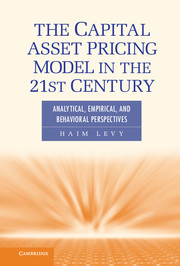 The Capital Asset Pricing Model in the 21st Century
The Capital Asset Pricing Model in the 21st Century Book contents
- Frontmatter
- Contents
- Preface
- 1 Introduction
- 2 Expected Utility Theory
- 3 Expected Utility and Investment Decision Rules
- 4 The Mean-Variance Rule (M-V Rule)
- 5 The Capital Asset Pricing Model
- 6 Extensions of the Capital Asset Pricing Model
- 7 The Capital Asset Pricing Model Cannot Be Rejected
- 8 Theoretical and Empirical Criticism of the Mean-Variance Rule
- 9 Prospect Theory and Expected Utility
- 10 Cumulative Decision Weights
- 11 The Mean-Variance Rule, the Capital Asset Pricing Model, and the Cumulative Prospect Theory
- References
- Name Index
- Subject Index
7 - The Capital Asset Pricing Model Cannot Be Rejected
Empirical and Experimental Evidence
Published online by Cambridge University Press: 05 June 2012
- Frontmatter
- Contents
- Preface
- 1 Introduction
- 2 Expected Utility Theory
- 3 Expected Utility and Investment Decision Rules
- 4 The Mean-Variance Rule (M-V Rule)
- 5 The Capital Asset Pricing Model
- 6 Extensions of the Capital Asset Pricing Model
- 7 The Capital Asset Pricing Model Cannot Be Rejected
- 8 Theoretical and Empirical Criticism of the Mean-Variance Rule
- 9 Prospect Theory and Expected Utility
- 10 Cumulative Decision Weights
- 11 The Mean-Variance Rule, the Capital Asset Pricing Model, and the Cumulative Prospect Theory
- References
- Name Index
- Subject Index
Summary
Introduction
One can evaluate the validity of the Capital Asset Pricing Model (CAPM, also called the SLB model for Sharpe, Lintner, and Black, whose contribution, development of the equilibrium risk–return relation, is discussed in detail in Chapter 5) by two alternative methods: (1) by examining the assumptions needed to the CAPM, and (2) by its empirical explanatory power. A short glimpse at the assumptions made to derive the CAPM is sufficient to raise skepticism regarding the model's validity. Thus, examining the CAPM's assumptions reveals a discouraging result because most of these assumptions do not hold in practice and therefore can barely be justified.
Let us demonstrate this claim with only two of these assumptions. In the CAPM derivation, it is assumed that investors select their optimal portfolio by the M-V criterion. This assumption can be theoretically justified when the distribution of returns are jointly “normal” (although there is some generalization of the Mean-Variance [M-V] rule to all elliptic distributions, without loss of generality, we explain the main idea given here with normal distributions). Theoretically, rates of returns can never be precisely normal because prices are bounded from below (i.e., the stock price can be zero but not negative). Another assumption that is employed in the derivation of the CAPM is the one that assumes no transaction cost and perfect investment divisibility; this assumption implies that even an individual investor with a relatively small amount of money to be invested can fully diversify and buy all available risky assets. This is, of course, an unrealistic assumption because in practice, transaction costs constitute a barrier to the number of assets one can purchase. By the same token, one can criticize the other assumptions that are employed in the derivation of the CAPM. Hence, with this theoretical approach, the CAPM would be rejected because most assumptions needed to derive it do not hold in practice.
- Type
- Chapter
- Information
- The Capital Asset Pricing Model in the 21st CenturyAnalytical, Empirical, and Behavioral Perspectives, pp. 186 - 238Publisher: Cambridge University PressPrint publication year: 2011
- 1
- Cited by


